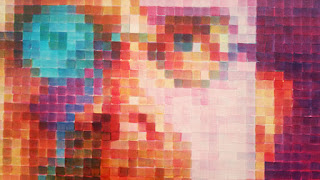Many times an artist doesn't know. I have started painting on a blank canvas with no idea in mind.
The next question is, "Does that work?" Sometimes it does but I don't think it's the best case scenario for creating art.
At the moment I'm working on colorful, small paintings. My inspiration for what to put on the canvas comes from a variety of land areas and structures that stuck in my memory from different places I have lived or visited.
However, we might also look at the great works of art in history to find out more.
Rousseau
This painting by Henri Rousseau is of a tiger caught in a storm. Anyone who has seen his lush, beautiful, tropical paintings would assume that he lived in that environment. Yet, that's not the case at all. As many appreciators of Rousseau, I was surprised to learn that he never left France in his lifetime. He was inspired by botanical textbooks and stories from others. Clever and imaginative man, that Rousseau!
Monet
This painting is one of 250 paintings that Monet did of his garden in Giverny, France. They were the main focus of his art for the last 30 years of his life. As anyone who has studied nature knows, the scene is never the same with light and color changes minute by minute. The frustration that artist feels in trying to capture an ever changing moment and always failing is a major inspiration. This is why Monet painted the same scenes over and over, trying to catch that elusive moment in time. Why didn't he get bored painting the same scene over and over? The more an artist gets into subtleties of what they are painting the more challenging and exciting the painting is to the artist.
Kandinsky
Wassily Kandinsky's color studies drawing is one of his most famous works. For Kandinsky color was the inspiration for his artwork. He wrote about color and their effects on each other. He felt he could hear color.
Reiss
Inspired by the Ash Can school of painting, Lionel Reiss captures a group of people ascending a staircase in New York in this watercolor, "Going Home". The inspiration for the Ash Can group was that they wanted to tell the truth about the lives of the working class and middle class in urban settings. They felt that art at that time focused on the genteel too frequently. Their goal was to record what they saw. The movement is an early 20th century one and during the 1930's some focused on poverty and the dreadful conditions of the lower classes.
















































